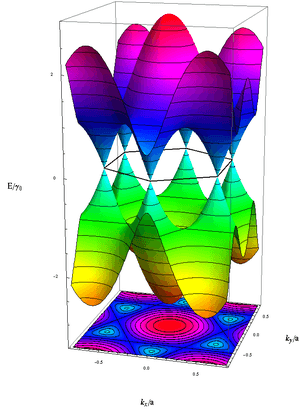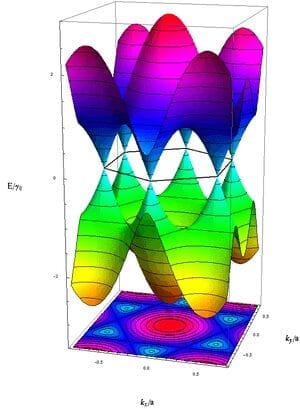
“Who knows what surprises are just around the corner.”
Unique properties of graphene and graph Exeter combine to create a new flexible, transparent, photosensitive device
Smart electronics are taking the world by storm. From techno-textiles to transparent electronic displays, the world of intelligent technology is growing fast and a revolutionary new device has just been added to its ranks. Researchers at the University of Exeter have developed a new photoelectric device that is both flexible and transparent. The device, described in a paper in the journal ACS Nano, converts light into electrical signals by exploiting the unique properties of the recently discovered materials graphene and graphExeter. GraphExeter is the best known room temperature transparent conductor and graphene is the thinnest conductive material.
At just a few atoms thick, the newly developed photoelectric device is ultra-lightweight. This, along with the flexibility of its constituent graphene materials, makes it perfect for incorporating into clothing. Such devices could be used to develop photovoltaic textiles enabling clothes to act as solar panels and charge mobile phones while they are being worn.
Photosensitive materials and devices such as the one developed at Exeter can, in the future, also be used for intelligent windows that are able to harvest electricity and display images while remaining transparent. Smart materials have almost unlimited potential applications from integral iPods and keyboards in clothing to electronic displays on glasses and goggles.
Saverio Russo, Professor of Physics at the University of Exeter said: “This new flexible and transparent photosensitive device uses graphene and graphExeter to convert light into electrical signals with efficiency comparable to that found in opaque devices based on graphene and metals.
“We are only just starting to explore the interfaces between different materials at very small scales and, as this research shows, we are revealing unique properties that we never knew existed. Who knows what surprises are just around the corner.”
The Latest Bing News on:
Smart electronics
- Google is updating Android TVs to fix a big Gmail privacy problemon April 25, 2024 at 2:39 pm
Google is working on a fix to block crafty individuals from gaining access to the emails of accounts logged in to some Android TV units. The Android TV operating system, which is preloaded on many ...
- Elon Musk’s X announces smart TV app on the wayon April 24, 2024 at 2:45 pm
Musk says he wants to transform X into a do-everything app for messages, video, payments, shopping and the works ...
- X Is Getting a Video App for Smart TVson April 24, 2024 at 10:00 am
Everything old is new again. After killing the pre-TikTok short-form video platform Vine in 2017, Twitter is using its new overhaul as X to relaunch its video initiative. That includes a smart TV app, ...
- X plans to launch big screen video app for smart TVson April 24, 2024 at 5:58 am
Video is seen as a key way for social network X to arrest declining advertising revenue since its takeover by Elon Musk.
- X TV is coming, along with an app for your Smart TVon April 24, 2024 at 5:26 am
Elon Musk unveils X TV to disrupt the smart TV industry. Learn about the possibilities that make it an exciting addition to your living room.
- Elon Musk wants to invade your smart TVon April 23, 2024 at 7:13 pm
An update posted by @XNews on X (formerly Twitter) suggests that billionaire Elon Musk has plans to launch a smart TV app called X TV (via Engadget ). Not much can be garnered from the 10-second video ...
- Amazon deals on smart TVs: Up to 42% off Amazon Fire TVs, TOSHIBA and moreon April 23, 2024 at 1:43 pm
Amazon has deals on smart televisions you won't want to miss. Right now, Amazon is offering discounted Amazon Fire TVs and other brands' smart TVs with Fire TV built-in. For example, the Toshiba ...
- X planning smart TV app, promising ‘immersive entertainment’on April 23, 2024 at 9:42 am
X is planning to roll out an application for users on smart TVs, the company’s chief executive said on Tuesday. “Soon we’ll bring real-time, engaging content to your smart TVs with the ...
- Average number of smart devices in a home 2024on April 22, 2024 at 4:59 pm
More recently, a new type of technology has grown in popularity: smart devices. Smart devices usually refer to consumer electronics that can be controlled over the internet, providing greater ...
- The Best Smart TVs in 2024on April 17, 2024 at 6:00 am
Smart TVs are here to stay and that's great news! We gathered our top smart TVs for 2024 so you can know which one is best for your space.
The Latest Google Headlines on:
Smart electronics
[google_news title=”” keyword=”smart electronics” num_posts=”10″ blurb_length=”0″ show_thumb=”left”] [/vc_column_text]The Latest Bing News on:
Photosensitive device
- Astigmatism and Vision Correction: What to Knowon April 27, 2024 at 5:27 am
In astigmatism, the cornea (the clear dome that covers your eye) or the lens (which focuses light rays on the light-sensitive retina) is abnormally shaped. Wearing contact lenses or glasses that ...
- Device for detecting retinal disease takes top prize in UTSA’s spring Tech Symposiumon April 25, 2024 at 5:00 pm
First place winners EyeSpy Innovators won a $4,000 cash prize for developing a cost-effective device that detects diabetic retinopathy. Five Design II teams also received awards of excellence at the ...
- Ohio company hawks fire-breathing robot dog that can torch anything in its pathon April 25, 2024 at 12:07 pm
Ohio-based company Throwflame has created a robotic dog named the Thermonator that is capable of emitting 30-foot jets of fire.
- How your phone's fingerprint sensor workson April 25, 2024 at 6:58 am
Most smartphones use capacitive or ultrasonic fingerprint sensors for authentication. The technologies are a little different, but both work well.
- Scientists reveal working mechanism of multilayer MoS₂ photodetector with broad spectral range and multiband responseon April 24, 2024 at 9:27 am
A research team from the school of Electronic Science and Engineering of Southeast University has developed wideband MoS2 photodetector, covering a range from 410 to 1550 nm. Through a series of ...
- Watch: Fire-breathing robot dog that can torch anything in its pathon April 23, 2024 at 6:48 am
A flame-throwing robotic dog has been invented by a company in the United States that is capable of delivering “on-demand fire anywhere”. Called the Thermonator, the remote-controlled device is for ...
- Will the Nothing Phone (3) Be the Flagship Killer We Desire? I Don’t Think Soon April 19, 2024 at 6:49 pm
The Nothing Phone (3) is due launch later this year but it might not be the flagship killer you are expecting it to be.
- What is red light therapy and can it solve your skin concerns?on April 18, 2024 at 7:24 am
Red light therapy is all the rage at the moment. But what is red light therapy, exactly, and is it worth the hype? We talked to skincare experts to find out.
- Microchip Manufacturingon April 18, 2024 at 4:27 am
one billionth of a metre **light-sensitive materials composed of elements including a polymer that changes structure when exposed to radiation ...
- The color of sleep: Decoding the impact of blue light on circadian rhythmon April 13, 2024 at 7:43 am
A new study has found that the color of light may not have the significant impact on circadian rhythm and sleep that was previously assumed.
The Latest Google Headlines on:
Photosensitive device
[google_news title=”” keyword=”photosensitive device” num_posts=”10″ blurb_length=”0″ show_thumb=”left”]










